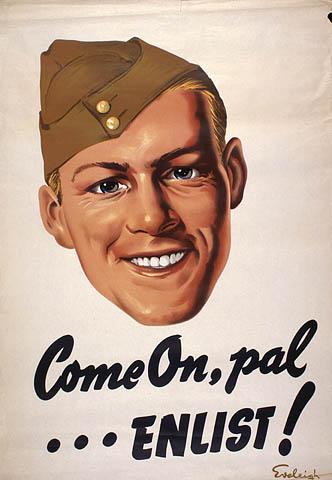Conscription is the drafting of people for mandatory military service. Canadians have been conscripted twice in history. Both times, only males were conscripted. The first time was during the First World War. The second time was during the Second World War. Conscription was an issue that divided Canada. Most English-speaking Canadians supported it. Most French-speaking Canadians opposed it.
(This article is a plain-language summary of Conscription in Canada. If you are interested in reading about this topic in more depth, please see the full-length entry.)

Conscription in the First World War
Canada did not have conscription when the First World War started. Instead, men volunteered for the military. From 1914 until 1915, about 330,000 men volunteered. Canada had enough soldiers at the time. But by 1916, things had changed. The death toll in the war was very high. By the summer of 1917, more than 130,000 Canadians had been killed or injured. The horrors of the war led to fewer volunteers.
Prime Minister Robert Borden knew that the war effort required more soldiers. He decided to introduce conscription. This was not popular with French Canadians. Sir Wilfrid Laurier, the Liberal leader, opposed it. Henri Bourassa, an important Quebec nationalist, was also against it.
Borden’s government passed the Military Service Act on 20 September 1917. All male citizens between ages 20 and 45 could be conscripted. Quebec was against it. But it was popular among English Canadians. They wanted to support their troops already overseas. The Act was also popular because it gave women in the military and women who were close relatives of men in the military the right to vote. Borden knew they would vote for him.

The 1917 Election
The election of 1917 was held on 17 December. Conscription was the biggest issue in the election. To ensure a victory, Borden tried to form a coalition government with Laurier’s Liberals. But Laurier refused. So instead, Borden formed a Union government with a group of Liberal Party members and independents. Borden’s Union government won the election. But he won only three seats in Quebec. He was very unpopular there. Many farmers in the West did not like him, either. They needed their sons to farm, not to fight.
1918 Anti-Conscription Riots
On 28 March 1918, anti-conscription riots occurred in Québec City. They ended on 1 April. Ottawa declared martial law and sent 6,000 soldiers there. Protesters fought against the soldiers and the soldiers fought back. In the end, four civilians were killed and 150 were wounded. The protesters were unarmed. The riots further divided English and French Canada.
In total, about 125,000 men were conscripted during the First World War. Only about 24,000 were sent to fight.
Conscription During the Second World War
Prime Minister William Lyon Mackenzie King did not want to conscript men during the Second World War. He did not want Quebec to turn against him. But he knew that many anglophones wanted conscription. King said his government would not conscript soldiers to fight abroad. But by June 1940, Belgium and France had fallen to Nazi Germany. Many Canadians wanted to boost the country’s war effort. The National Resources Mobilization Act was passed on 21 June 1940. It allowed conscription only for home defence. Montreal mayor Camillien Houde spoke out against the Act. He was interned for four years after he urged people to ignore their call-up papers.

By 1941, fewer men were volunteering for the military. King decided to have a non-binding referendum on conscription. Most people in Quebec voted against it. All other provinces voted for it, with around 80 per cent in favour. Bill 80 was then passed. It gave the government permission to conscript soldiers to serve abroad. King hoped he would not have to use conscription, but he did. After the D-Day invasion in June 1944, the Canadian military was losing strength and needed more troops. (See also Mackenzie King and the War Effort.)
In the end, only around 13,000 soldiers went abroad. Fewer than 2,500 reached the front lines. French Canadians were angry, but not nearly as angry as they were during the First World War.

 Share on Facebook
Share on Facebook Share on X
Share on X Share by Email
Share by Email Share on Google Classroom
Share on Google Classroom







